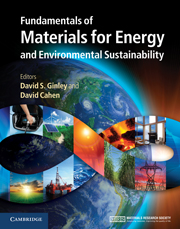Book contents
- Frontmatter
- Contents
- Contributors
- Preface
- Acknowledgments
- Part 1 Energy and the environment: the global landscape
- Part 2 Nonrenewable energy sources
- Part 3 Renewable energy sources
- Part 4 Transportation
- Part 5 Energy efficiency
- 35 Lighting
- 36 Energy efficient buildings
- 37 Insulation science
- 38 Industrial energy efficiency: a case study
- 39 Green processing: catalysis
- 40 Materials availability and recycling
- 41 Life-cycle assessment
- Part 6 Energy storage, high-penetration renewables, and grid stabilization
- Summary
- Appendix A Thermodynamics
- Appendix B Electrochemistry
- Appendix C Units
- Index
- References
35 - Lighting
from Part 5 - Energy efficiency
Published online by Cambridge University Press: 05 June 2012
- Frontmatter
- Contents
- Contributors
- Preface
- Acknowledgments
- Part 1 Energy and the environment: the global landscape
- Part 2 Nonrenewable energy sources
- Part 3 Renewable energy sources
- Part 4 Transportation
- Part 5 Energy efficiency
- 35 Lighting
- 36 Energy efficient buildings
- 37 Insulation science
- 38 Industrial energy efficiency: a case study
- 39 Green processing: catalysis
- 40 Materials availability and recycling
- 41 Life-cycle assessment
- Part 6 Energy storage, high-penetration renewables, and grid stabilization
- Summary
- Appendix A Thermodynamics
- Appendix B Electrochemistry
- Appendix C Units
- Index
- References
Summary
Focus
Electricity generation is the main source of energy-related greenhouse-gas emissions, and lighting uses one-fifth of its output. Solid-state lighting (SSL) using light-emitting diodes (LEDs) is poised to reduce this value by at least 50%, so that lighting will then use less than one-tenth of all electricity generated. The use of LEDs for lighting will provide reductions of at least 10% in fuel consumption and carbon dioxide emissions from power stations within the next 5–10 years. Even greater reductions are likely on a 10–20-year time scale.
Synopsis
Artificial lighting is one of the factors contributing significantly to the quality of human life. Modern light sources, such as incandescent light bulbs (a heated tungsten wire in a bulb that is evacuated or filled with inert gas) and compact fluorescent lamps (a phosphor-coated gas discharge tube), use electricity to generate light. Worldwide, grid-based electric lighting consumed about 2650 TW·h of electricity in 2005, some 19% of total global electricity consumption [1]. Using an average cost of $2.8 per megalumen-hour (Mlm·h), the International Energy Agency estimated that the energy bill for electric lighting cost end-users $234 billion and accounted for two-thirds of the total cost of electric-lighting services ($356 billion), which includes lighting equipment and labor costs as well as energy. The annual cost of grid-based electric lighting is about 1% of global gross domestic product.
- Type
- Chapter
- Information
- Publisher: Cambridge University PressPrint publication year: 2011
References
- 1
- Cited by



